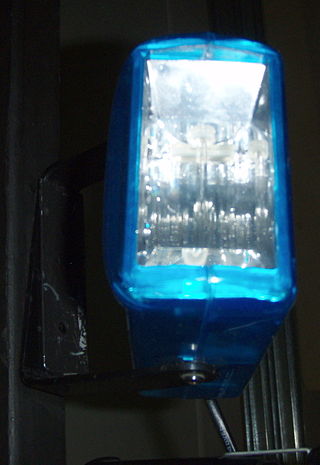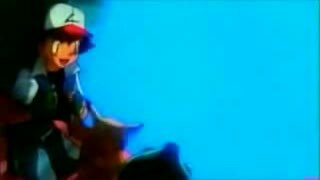
An epileptic seizure, informally known as a seizure, is a period of symptoms due to abnormally excessive or synchronous neuronal activity in the brain. Outward effects vary from uncontrolled shaking movements involving much of the body with loss of consciousness, to shaking movements involving only part of the body with variable levels of consciousness, to a subtle momentary loss of awareness. Most of the time these episodes last less than two minutes and it takes some time to return to normal. Loss of bladder control may occur.

A strobe light or stroboscopic lamp, commonly called a strobe, is a device used to produce regular flashes of light. It is one of a number of devices that can be used as a stroboscope. The word originated from the Ancient Greek στρόβος (stróbos), meaning "act of whirling".

The occipital lobe is one of the four major lobes of the cerebral cortex in the brain of mammals. The name derives from its position at the back of the head, from the Latin ob, 'behind', and caput, 'head'.
Epilepsy Action is a British charity providing information, advice and support for people with epilepsy.
A gamma wave or gamma rhythm is a pattern of neural oscillation in humans with a frequency between 25 and 140 Hz, the 40 Hz point being of particular interest. Gamma rhythms are correlated with large-scale brain network activity and cognitive phenomena such as working memory, attention, and perceptual grouping, and can be increased in amplitude via meditation or neurostimulation. Altered gamma activity has been observed in many mood and cognitive disorders such as Alzheimer's disease, epilepsy, and schizophrenia. Elevated gamma activity has also been observed in moments preceding death.
Light sensitivity or photosensitivity refers to a notable or increased reactivity to light. Apart from vision, human beings have many physiological and psychological responses to light. In rare individuals an atypical response may result in serious discomfort, disease, or injury. Some drugs have a photosensitizing effect. Properties of natural or artificial light that may abnormally affect people include:

An aura is a perceptual disturbance experienced by some with epilepsy or migraine. An epileptic aura is a seizure.

"Dennō Senshi Porygon" is the 38th episode of the Pokémon anime's first season. Its sole broadcast was in Japan on December 16, 1997.
Reflex seizures are epileptic seizures that are consistently induced by a specific stimulus or trigger making them distinct from other epileptic seizures, which are usually unprovoked. Reflex seizures are otherwise similar to unprovoked seizures and may be focal, generalized, myoclonic, or absence seizures. Epilepsy syndromes characterized by repeated reflex seizures are known as reflex epilepsies. Photosensitive seizures are often myoclonic, absence, or focal seizures in the occipital lobe, while musicogenic seizures are associated with focal seizures in the temporal lobe.
In medicine, Intermittent Photic Stimulation, or IPS, is a form of visual stimulation used in conjunction with electroencephalography to investigate anomalous brain activity triggered by specific visual stimuli, such as flashing lights or patterns.

The Epilepsy Society is the largest medical charity in the field of epilepsy in the United Kingdom, providing services for people with epilepsy for over 100 years. Based in Chalfont St Peter, Buckinghamshire, UK, its stated mission is "to enhance the quality of life of people affected by epilepsy by promoting research, education and public awareness and by delivering specialist medical care and support services." The Epilepsy Society has close partnerships with the National Hospital for Neurology and Neurosurgery and the UCL Institute of Neurology, both located in Queen Square, London.
The term seizure threshold is used to describe the balance between excitatory (glutaminergic) and inhibitory (GABA-ergic) forces in the brain which affect how susceptible a person is to seizures. Those diagnosed with epilepsy or certain other neurological conditions are more vulnerable to seizures if the threshold is reduced, and should be compliant with their anticonvulsant drug regimen.
The term Harding test is generically understood to mean an automatic test for photosensitive epilepsy (PSE) provocative image sequences in television content. This is properly known as a PSE test since the publication of the Digital Production Partnership (DPP) technical requirements and the DPP PSE Devices document updated in November 2018.
Generally, seizures are observed in patients who do not have epilepsy. There are many causes of seizures. Organ failure, medication and medication withdrawal, cancer, imbalance of electrolytes, hypertensive encephalopathy, may be some of its potential causes. The factors that lead to a seizure are often complex and it may not be possible to determine what causes a particular seizure, what causes it to happen at a particular time, or how often seizures occur.
Idiopathic childhood occipital epilepsy of Gastaut (ICOE-G) is a pure but rare form of idiopathic occipital epilepsy that affects otherwise normal children and adolescents. It is classified amongst benign idiopathic childhood focal epilepsies such as rolandic epilepsy and Panayiotopoulos syndrome.
Jeavons syndrome is a type of epilepsy. It is one of the most distinctive reflex syndromes of idiopathic generalized epilepsy characterized by the triad of eyelid myoclonia with and without absences, eye-closure-induced seizures, EEG paroxysms, or both, and photosensitivity. Eyelid myoclonia with or without absences is a form of epileptic seizure manifesting with myoclonic jerks of the eyelids with or without a brief absence. These are mainly precipitated by closing of the eyes and lights. Eyelid myoclonia is the defining seizure type of Jeavons syndrome.
People with epilepsy may be classified into different syndromes based on specific clinical features. These features include the age at which seizures begin, the seizure types, and EEG findings, among others. Identifying an epilepsy syndrome is useful as it helps determine the underlying causes as well as deciding what anti-seizure medication should be tried. Epilepsy syndromes are more commonly diagnosed in infants and children. Some examples of epilepsy syndromes include benign rolandic epilepsy, childhood absence epilepsy and juvenile myoclonic epilepsy. Severe syndromes with diffuse brain dysfunction caused, at least partly, by some aspect of epilepsy, are also referred to as epileptic encephalopathies. These are associated with frequent seizures that are resistant to treatment and severe cognitive dysfunction, for instance Lennox-Gastaut syndrome and West syndrome.

Occipital epilepsy is a neurological disorder that arises from excessive neural activity in the occipital lobe of the brain that may or may not be symptomatic. Occipital lobe epilepsy is fairly rare, and may sometimes be misdiagnosed as migraine when symptomatic. Epileptic seizures are the result of synchronized neural activity that is excessive, and may stem from a failure of inhibitory neurons to regulate properly.
In visual perception, flicker is a human-visible change in luminance of an illuminated surface or light source which can be due to fluctuations of the light source itself, or due to external causes such as due to rapid fluctuations in the voltage of the power supply or incompatibility with an external dimmer.
Musicogenic seizure, also known as music-induced seizure, is a rare type of seizure, with an estimated prevalence of 1 in 10,000,000 individuals, that arises from disorganized or abnormal brain electrical activity when a person hears or is exposed to a specific type of sound or musical stimuli. There are challenges when diagnosing a music-induced seizure due to the broad scope of triggers, and time delay between a stimulus and seizure. In addition, the causes of musicogenic seizures are not well-established as solely limited cases and research have been discovered and conducted respectively. Nevertheless, the current understanding of the mechanism behind musicogenic seizure is that music triggers the part of the brain that is responsible for evoking an emotion associated with that music. Dysfunction in this system leads to an abnormal release of dopamine, eventually inducing seizure.






